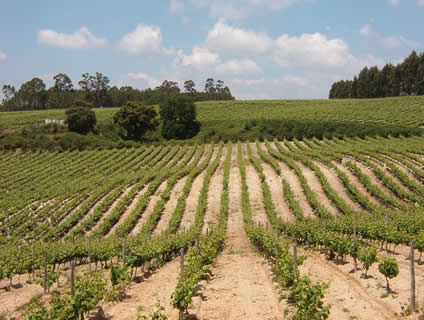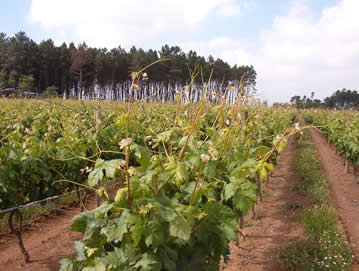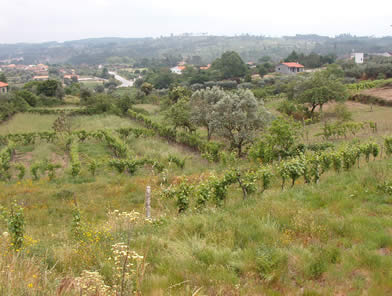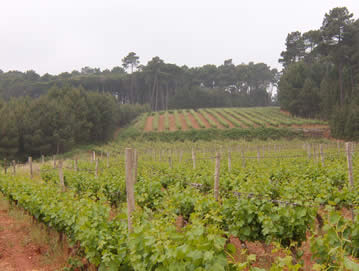
|
Spotlight
on Portugal's Dão region
Right at the heart of Portugal lies the Beira region, which
is divided into three sections, the Beira Litoral (the coastal
section, home to the Bairrada wine region), the Beira Alta (the upper
mountainous region, which is where Dão wine comes from) and the Beira
Baixa (the lower region). This part of the country is home to some of
Portugal’s most distinctive and distinguished red wines, and rapidly
improving whites.
So this climate, coupled with the granitic soils, creates
terrain perfect for making fine, elegant wines with good acid. And, as
with so much of Portugal, the relatively untapped potential is now
beginning to be realized on a large scale. In the past, progress in
the Dão has been hampered by restrictive wine laws that insisted that
almost all the grapes were processed by the big co-operatives. While
there’s no reason that co-ops can’t make good wine, they have
tended to take away any incentive for growers to excel in the vineyard
by paying them according to quantity of grapes produced, not their
quality. Over the last decade these restrictions have been removed and
the average quality of Dão wine has improved tremendously: it is a
region with a potentially exciting future. Investment by some of the
country’s leading wine producers has flowed into the region, and
there’s been a gradual shift away from the multitude of tiny
smallholdings towards properly designed and planted vineyards. In
addition, a number of small privately owned estates have pushed back
the boundaries of quality.
Dão is sometimes likened to Portugal’s Burgundy. It’s
not because of any physical similarity between the regions, but
because of the style of wine. Like red Burgundy, good
One of the keys to this individuality is the mix of grapes
employed: you won’t find international superstar grape varieties
like Cabernet Sauvignon and Merlot here. One of the unique selling
points of most Portuguese wines is their reliance on indigenous
varieties, and the Dão is no exception. Touriga Nacional is the
leading red variety of the Dão. On its own makes strikingly spicy,
peppery wines with lovely forest fruit character, but it is more
commonly blended with varieties such as Tinta Roriz (the Tempranillo
of Spain), Jaen and Alfrocheiro Preto. Many Portuguese winemakers are
experimenting with making wines from just a single variety, but the
general consensus is that blends work best. Dão also makes increasingly successful white wines, the
best displaying good concentration of fruit with refreshing acidity
and often some subtle nutty oak notes. Encruzado is the leading white
grape, often supported by Bical or Arinto, among others. But it's the
reds that are the real focus here. On my recent visit (May 2004) I checked out the leading producers, and I'll be writing up my impressions over the next few weeks (the following is the list of articles to come).
|

 What do you look for in a red wine? Do you favour elegance
over power and concentration? Do you prefer a wine that is balanced
and food friendly over one that’s soft and sweetly fruited? If so,
the red wines of Dão could be just what you are looking for. The key
to understanding these wines lies in the geography of the region. Dão
is surrounded by mountains, and the vineyards themselves are at
altitudes ranging from 200–900 m. This means that the region is
protected to a degree from the vagaries of the Atlantic weather system
to the west, but not fully exposed to the harsh continental climate to
the east. As a result, rainfall is high, but
What do you look for in a red wine? Do you favour elegance
over power and concentration? Do you prefer a wine that is balanced
and food friendly over one that’s soft and sweetly fruited? If so,
the red wines of Dão could be just what you are looking for. The key
to understanding these wines lies in the geography of the region. Dão
is surrounded by mountains, and the vineyards themselves are at
altitudes ranging from 200–900 m. This means that the region is
protected to a degree from the vagaries of the Atlantic weather system
to the west, but not fully exposed to the harsh continental climate to
the east. As a result, rainfall is high, but  most of this falls in the
winter months, leaving mostly hot, dry weather for the majority of the
grape growing season. The altitude also helps temper the heat and
allows the grapes to retain their all-important natural acidity. In
addition, the soils here are primarily granitic in origin (illustrated
left), with a high
proportion of sand or in some cases some clay. It’s a soil that also
tends to produce grapes with high acidity.
most of this falls in the
winter months, leaving mostly hot, dry weather for the majority of the
grape growing season. The altitude also helps temper the heat and
allows the grapes to retain their all-important natural acidity. In
addition, the soils here are primarily granitic in origin (illustrated
left), with a high
proportion of sand or in some cases some clay. It’s a soil that also
tends to produce grapes with high acidity. If
you get a chance to visit Dão, you'll probably have to look hard to
find the vineyards.
If
you get a chance to visit Dão, you'll probably have to look hard to
find the vineyards. 